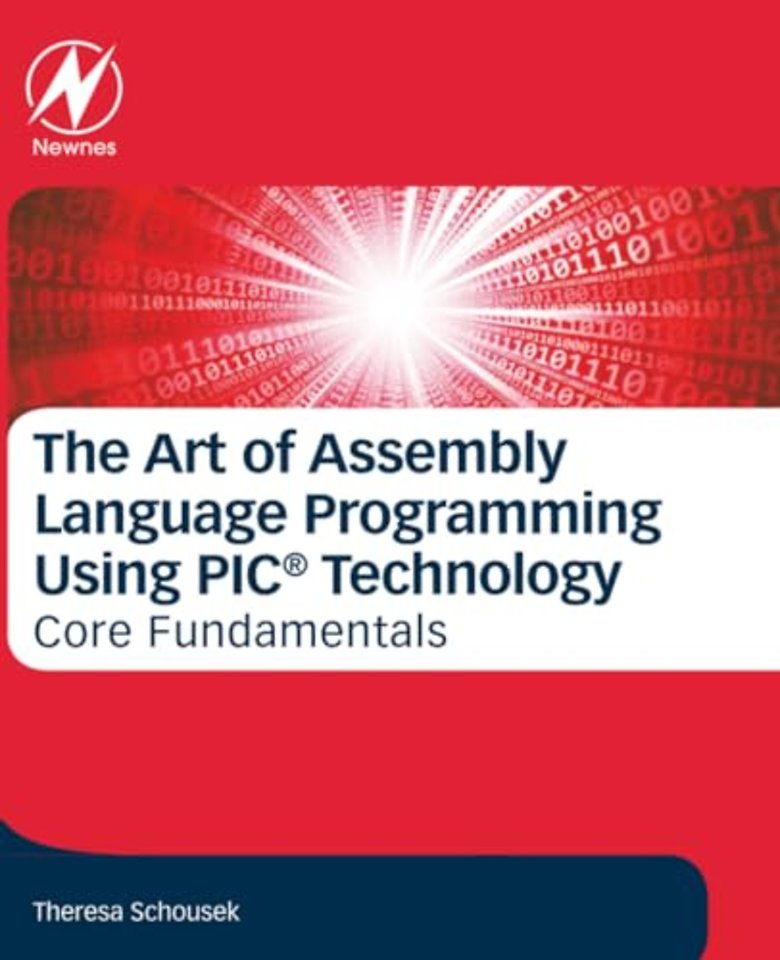


Theresa Schousek has been a Microchip (R) Design Partner for 20 years as President, Chief Engineer, and Owner of Vital Innovations LLC.
Meer over Theresa SchousekThe Art of Assembly Language Programming Using PIC (R) Technology
Core Fundamentals
Paperback Engels 2019 1e druk 9780128126172Samenvatting
The Art of Assembly Language Programming Using PICmicro Technology: Core Fundamentals thoroughly covers assembly language used in programming the PIC Microcontroller (MCU). Using the minimal instruction set characteristic of all PICmicro products, the author elaborates on how to execute loops, control timing and disassemble code from C mnemonics.
Detailed memory maps assist the reader with tricky areas of code, and appendices on basic math supplement reader background. In-depth coverage is further provided on paging techniques that are unique to PICmicro 16C57. This book is written for a broad range of skill levels, and is relevant for both the beginner and skilled C-embedded programmer.
In addition, a supplemental appendix provides advice on working with consultants, in general, and on selecting an appropriate consultant within the microchip design consultant program. With this book, users you will learn the symbols and terminology used by programmers and engineers in microprocessor applications, how to program using assembly language through examples and applications, how to program a microchip microprocessor, how to select the processor with minimal memory, and more.
Key Features
- Teaches how to start writing simple code, e.g., PICmicro 10FXXX and 12FXXX
- Offers unique and novel approaches on how to add your personal touch using PICmicro ‘bread and butter’ enhanced mid-range 16FXXX and 18FXXX processors
- Teaches new coding and math knowledge to help build skillsets
- Shows how to dramatically reduce product cost by achieving 100% control
- Demonstrates how to gain optimization over C programming, reduce code space, tighten up timing loops, reduce the size of microcontrollers required, and lower overall product cost
Readership
Electrical, Mechanical, Industrial engineers. Software Programmers trained in a higher level language, with no electrical engineering or embedded control background; Embedded/Firmware or Hardware designers, and Undergraduate Engineering students
Specificaties
Lezersrecensies
Inhoudsopgave
Purpose
Scope
Author’s Note
Dare we call it fun?
Chapter F1: INTRODUCTION
Practical Applications
Why Assembly?
Core Families (‘Baseline,’ ‘ Midrange,’ enhanced ‘Midrange’)
Data Sheet Walk Through
Straightline Program Implementation
Practice Exercise – Walk Through
Microchip Microcontroller Course Information
Jargon Introduction – italics
Further Reading
Chapter F2: MICROCHIP 8-BIT ARCHITECTURE
The Microprocessor
System Clock
Bus for Data and Program
Hardware Interfaces
Hardware Organization of Memory Address Space
Memory Interface
Program Data Storage Memory Circuits
Input/output Interface
Further Reading
Chapter F3: INSTRUCTION SETS
Fields of an Instruction (See Table 2-1 in 6809)
Instruction Set for PICmicro® Controllers
General Purpose Registers
Special Function Registers
Addressing: Direct, Indirect, Indexed, and Relative
Compare and Status Flags
Calculating Relative Offsets
Conditional Branches
Code Example
Further Reading
Chapter F4: BEGINNING CODE
8-bit Data Transfer
8-bit Addition
8-bit Subtraction
Shift left 1 bit (Multiply by two)
Shift left 2 bits (Multiply by four)
Clear a Memory Location
Set a Memory Location to All Ones
Find Larger of Two Numbers
Find Smaller of Two Numbers
Further Reading
Chapter F5: LOOPING CODE
8-bit Sum of Data
16-bit Sum of Data
Maximum Value
Minimum Value
Check-sum of Data
Number of Zero, Positive, and Negative Numbers
Count ‘1’ Bits
Further Reading
Chapter F6: EMBEDDED CONTROL FUNDAMENTALS
Electrical Wiring Diagrams (how to read diagrams)
Breadboards (how to use standard breadboards)
Basic GPIO I/O
Specialized I/O
Timer Modules and Registers
Comparator Module
Paging Consideration
Evaluation Boards
Further Reading
Chapter F7: FUNDAMENTALS of GOOD PRACTICE
Program Development
Structured Programming
Concept of Design Patterns and Interfaces
Pseudocode
Using Include files to Create Reusable Code
Program Design and Documentation
Programming Flow Charts
Warnier-Orr Diagrams
Systems Development
State Machine Diagrams
SYSML Systems Definition Language
Further Reading
Chapter F8: PROGRAMMING DATA STRUCTURES
Assembly Language Concepts
Arrays: String Handling and Character Operations
Pointer Constructs
Procedures
Functions
Assembly Language Basics
Simple Instructions
Config Word
Flags
Subroutines
Indexing
Assembly Language Advanced
Interrupts
Jump tables
Stack processing
Using DEFINE
Creating MACROS
Further Reading
Chapter F9: BOOLEAN LOGIC and NUMBERING SYSTEMS
Logical Operators
Sets and Truth Tables
AND
OR
Exclusive OR
Mask Off Most Significant 4 bits
Mask Off Least Significant 4 bits
Conditional functions (>,<,=,!=,>=,<=)
Complementing
Mathematical Numbering Systems
Binary, Hex and Decimal (with a mention of the existence of octal)
Multi-byte Integer Types
Signed Integers – cover 2s compliment extensively, but mention 1s compliment and sign-magnitude, because these still come out of some sensors and FPGAs.
Unsigned Integers
Floating Point (I doubt many people will want to use it in a PIC, but they may be given it and need to deal with it.)
BCD as a Type
Further Reading
Chapter F10: MATHEMATICAL OPERATIONS
Arithmetic Operations on Bytes
Arithmetic Operations on Multi-byte Numbers (Using carry properly, detecting overflow, how to treat signed and unsigned differently)
16-bit Data Transfer
16-bit Addition
16-bit Ones Complement
16-bit Twos Complement
Advanced Mathematical Operations
Shifting and Rotating, and How to Use Instructions in a Multi-Byte Shift
Application Notes Review:
Multiplication Algorithms, Both Signed and Unsigned
Division Algorithms
Floating Point
Further Reading
Appendices:
A: Instruction Set Reference Tables
B: Datasheet for PICmicro 10F
C: Decimal-Hexadecimal-Binary Tables
D: ASCII Table
Anderen die dit boek kochten, kochten ook
Rubrieken
- advisering
- algemeen management
- coaching en trainen
- communicatie en media
- economie
- financieel management
- inkoop en logistiek
- internet en social media
- it-management / ict
- juridisch
- leiderschap
- marketing
- mens en maatschappij
- non-profit
- ondernemen
- organisatiekunde
- personal finance
- personeelsmanagement
- persoonlijke effectiviteit
- projectmanagement
- psychologie
- reclame en verkoop
- strategisch management
- verandermanagement
- werk en loopbaan





